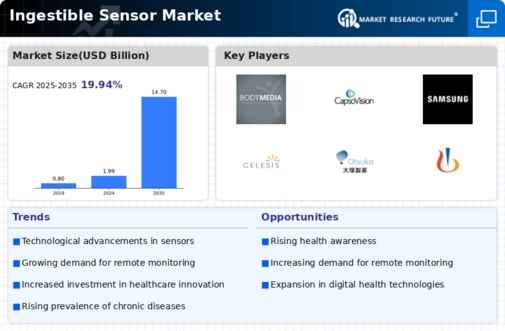Market Analysis
In-depth Analysis of Ingestible Sensor Market Industry Landscape
The Ingestible Sensor Market is driven by dynamic factors that shape its growth and evolution. One of the primary drivers is the increasing emphasis on preventive healthcare. There is a trend on wellness and proactive health management worldwide, it works the non-invasive means of continuous monitoring through ingestible sensors. More and more people tend to implement technologies that allow monitoring their health indicators in real-time, which positively contributes to the market’s dynamics.
Technological changes play an important role in the market dynamics for ingestible sensors. These devices are advanced with continuous innovation in sensor technology, miniaturization and data analytics. Seamless communication and data transmission are possible through the integration of advanced sensors with wireless connectivity, which allows remote monitoring and timely intervention by healthcare professionals. The emergence of newer and advanced ingestible sensor products is likely to happen as technology continues evolving.
The worldwide prevalence of chronic diseases significantly influences the market dynamics. Swallowable sensors are a great aid in dealing with chronic conditions such as diabetes, cardiovascular diseases and gastrointestinal disorders. Constant monitoring of the key health parameters allows identifying issues in their early stages, which helps to perform appropriate interventions as well as personalize healthcare management. With the burden of chronic diseases anticipated to increase steadily, demand for effective monitoring systems will act as a key driver for growth in ingestible sensor market.
The use of ingestible sensors is greatly regulated an this makes the confidence increased in both patients and healthcare providers. The regulatory approvals are necessary for the entry to markets, while the manufacturers should meet certain standards. Such revisions of regulatory standards can alter the speed in which new products are on shelves and become widely adopted, all affecting how ingestible sensor market dynamics take shape.
The economic state of the environment also impacts market dynamics with issues like healthcare spending, insurance coverage and affordability. The price of health care interventions, including ingestible sensors plays a major role in determining the adoption. The ebb and flow of the market is attributed to economic factors that control disposable income levels for households as well as entry into healthcare services. Manufacturers usually take to planning in order to ensure lower production costs and reduce the prices of their products, thereby enabling more persons within a population access them.
The firms seek to fortify their market position due to strategic partnerships with other companies, acquiring innovative startups or mergering complementary businesses. This dynamic environment creates a competitive field, innovation and identification of strategic players with diverse portfolios that transform the overall structure of market globally.
Consumer awareness and acceptance plays a crucial role in determining the market dynamics. The general population accept ingestible sensors owing to educational initiatives, awareness campaigns and positive user experience. As individuals become more informed about the benefits of these devices, the market is likely to witness increased adoption and a shift towards a more proactive approach to personal health management.
















Leave a Comment